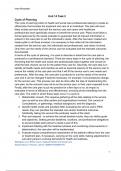Iman Moazakar
Unit 14 Task 2
Cycle of Planning
The cycle of planning refers to health and social care professionals liaising to create an
official plan that includes the treatment and care of an individual. This plan will most
likely include services that both the service user and carers and healthcare
professionals have specifically chosen to benefit the service user. Plans must follow a
format approved by the needs evaluator to guarantee that all relevant information is
present in the care plan to suit the individual's needs. After this has been created and
made public to all those involved, it is necessary to first collect all the information
needed from the service user, the individuals and professionals, and others involved.
Only then can the needs of the service user be evaluated and the intended outcomes
documented.
In terms of the cycle of planning, it is used to describe in detail how the care plan is
produced to a professional standard. There are many steps in the cycle of planning, the
first being that the health and social care professionals liaise together and consult on
what the best choices can be for the patient they care for. Secondly, the next step is to
identify all health needs and priorities as well as personal reasons of the service user to
ensure the validity of the care plan and that it will fit the service user's own needs and
preferences. After this step, the care plan is produced to suit the needs of the service
user and it can be changed if deemed necessary, for example, if circumstances change
for the service user. This process can also be done after the step of implementing the
care plan, as the outcome may not be as the service user, or their carer expected to be.
Finally, after the care plan is put into practice for a few days or so, its impact is
evaluated in terms of efficiency and effectiveness, ensuring all are benefiting from the
care plan. The order in which these steps occur in a cycle is:
1. Stakeholder consult -This requires gathering all the data relating to the service
user as well as any other parties and organisations involved. Can consist of
Consultations, or gatherings, medical background, and the diagnosis.
2. Identify health needs and priorities-After evaluating the service user's PIES
needs, they can prioritise the intended care and/or treatment outcomes
holistically, taking into account the particular needs of the client.
3. Plan and respond - to achieve the overall desired results, they can define goals
and objectives. Setting precise deadlines, locations, and professional obligations
to accommodate each person's needs is part of this.
4. Implement-Starting with the treatment phases and monitoring (improvements or
deterioration), the care plan will be implemented.
5. Evaluate impact-comprehensive assessment of the patient's effects from the care
or treatment plan. if necessary, carrying on the cycle while making adjustments to
suit each person's evolving demands for health and wellness.
‘Billingham et al, BTEC Level 3 National Health and Social Care
Student Book 2, Pearson, (2010), ISBN9781846907470’
1
, Iman Moazakar
Potential care methods and strategies - P5
Three types of different care can help ensure the best type of care is given to service
users with all types of illnesses and disorders, may it be diabetes type 2 to lung cancer.
These are known as primary care, secondary care, and tertiary care.
Primary Care:- Primary care is the first point of contact in the health and social care
system. It mostly includes all NHS organisations, such as GP surgery, a pharmacy,
opticians, and even dentistry.
Secondary Care:- Secondary care is being cared for/treated by a professional individual
who has specialised knowledge in caring for a particular type of disorder, such as a
cardiologist. A service user is referred to secondary care by their GP if the GP is unable
to treat them because their disorder/illness needs a more specialised
doctor/professional to care for them. Secondary care can take place in a Hospital,
clinics, and specialised organisations specific to the disorders needing urgent treatment.
Tertiary Care:- Service users resort to using tertiary care, which is known to have the
most highly specialist care available for service users with disorders/disabilities etc.
Examples of tertiary care include neurosurgery, mental health services, transplant
surgeries, plastic surgery, etc.
Assessing the care needs of Layan – P5
Case Study
Layan is a 45 year old woman. She is a patient of CHD, as she has recently been
diagnosed.
Her health/physical needs are that she is partially obese so she gets tired easily.
Mental:- she suffers from post-natal depression after she had her recent child, Hamza,
who is a few months old.
Intellectual:- She doesn't understand English properly and only understands a little bit.
She cannot speak English.
Social:- She is very social and is a part of the town's community.
She is a Muslim woman, so she has a few religious needs.
Informal carers:- her husband, is at work mostly, so her mother looks after her. Her
mother is 71. Her mother is old and therefore needs care too. Mother cannot care for
Layan and Layan cannot care for her mother at times.
Her financial circumstances are that she does not work, as she is a housewife. So her
husband does not own enough money for a family of 7.
She lives in a very busy area, there is a lot of traffic.
2




